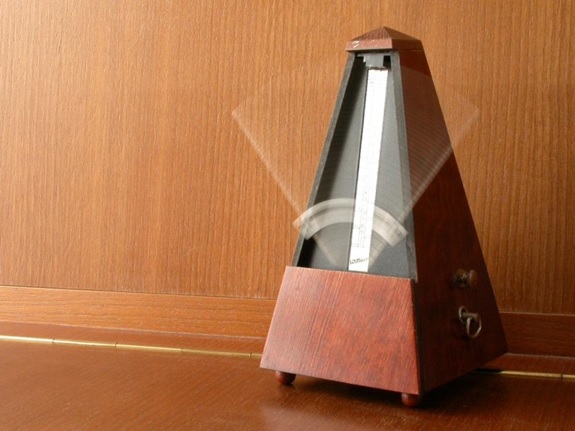
The ability to play in time, one of the most fundamental skills that a musician must develop, is to play with a consistent, even, and steady pulse as well as playing rhythmic phrases with accuracy and precision. Playing with good time is just as important in solo playing as it is in an ensemble environment. Without a good sense of time, the music will lose its momentum, fluency, and ultimately its groove—a word we will discuss in a future next article. Given that time is such an important skill to develop, as musicians we should know exactly how to develop it. This is where a metronome can come in extremely helpful.
Metronome - what’s it for?
There is a common misconception amongst many musicians that a metronome is a tool to keep us in time. While this can be true, for example, if you’re playing a gig along to a click track, this is not its most effective purpose. Rather, it should be used as a tool to help us make regular, noticeable improvements to our own sense of pulse and time.
In this and the next articles, we will explore some of the most effective ways to use a metronome in exactly this way, so please make sure that you have a metronome that can be set to an extremely low tempo. Many digital metronomes have a lowest tempo of around 40 beats per minute, this won’t be suitable and you’ll need one that can go as low as about 4 beats per minute (mine can go as low as 1). If you don’t have a digital metronome, I’d highly recommend acquiring one, as traditional pyramid metronomes often struggle with consistency at lower tempos. Both the Google Play Store and Apple App Store have a load of metronomes to choose from and many of them are free such as ‘Metronome Beats’ available from the Play Store, and ‘Pro Metronome’ if you’re an Apple user.
Metronome Reduction
The first technique I’d like to share is one that I call ‘metronome reduction.’ It can be used while playing anything with a steady pulse and, like all metronome practice concepts, doesn’t work well with rubato or free time playing. The first thing to understand with this technique is that you will not change tempo; instead, the metronome is what changes. Here’s how it works:
- Decide on an exercise, groove, pattern, scale, improvisation, etc., anything that’s in time. Then decide on a tempo. This exercise works best at the following tempos: 40, 60, 80, 100, 120, 160, 200 beats per minute.
- Set your metronome to the tempo you decided and begin playing. Focus on hitting each beat exactly in time and get completely comfortable with the tempo.
- Once you are completely comfortable, change the metronomes tempo to exactly half the original tempo, e.g. 80bpm – 40bpm
- You will now hear a click on beats 1 and 3 of each bar. Continue with the same exercise. This could be for a predetermined length of time or for as long as you feel necessary for you to have the music completely under control.
- Once again, halve the metronome, e.g. 40bpm – 20bpm.
- You’re now only hearing the metronome on beat 1 of each bar. Continue playing as previously. You’ll notice that the role of the metronome has now changed. It is no longer keeping you in time, it is telling you whether you’re playing in time.
- The process can be repeated, e.g. 20bpm – 10bpm.
- You’ll now only hear a click on beat 1 of every other bar.
If you really struggle with any of the steps, take a step back. If the exercise you’re trying to play is too hard to play in step 2, then you should begin with a lower starting tempo. This exercise works better in duple or quadruple time; it is possible to try this exercise with time signatures such as 3/4, although this is much more difficult as the metronome will begin playing syncopations.
Next time we will focus on some more metronome tips. Until then, familiarise yourself with this exercise and any subsequent exercises will be much easier to grasp.
This is part 4 of our article series: Making the Most of Your Practice. Check out the other articles on
⇒Part 1: Making Practice Enjoyable
⇒Part 2: Setting Practice Goals
⇒Part 3: Practice Planning
Image by Paco from Badajoz, España (Flickr) via Wikimedia Commons [CC BY 2.0 (http://creativecommons.org/licenses/by/2.0)]
Ready to learn music?
Start learning with our 30-day free trial! Try our courses now!About Liberty Park Music
LPM is an online music school. We teach a variety of instruments and styles, including classical and jazz guitar, piano, drums, and music theory. We offer high-quality music lessons designed by accredited teachers from around the world. Our growing database of over 350 lessons come with many features—self-assessments, live chats, quizzes etc. Learn music with LPM, anytime, anywhere!
